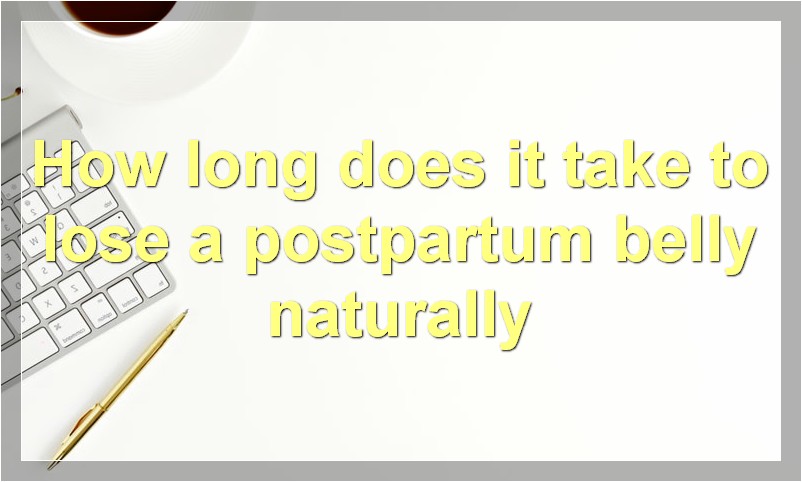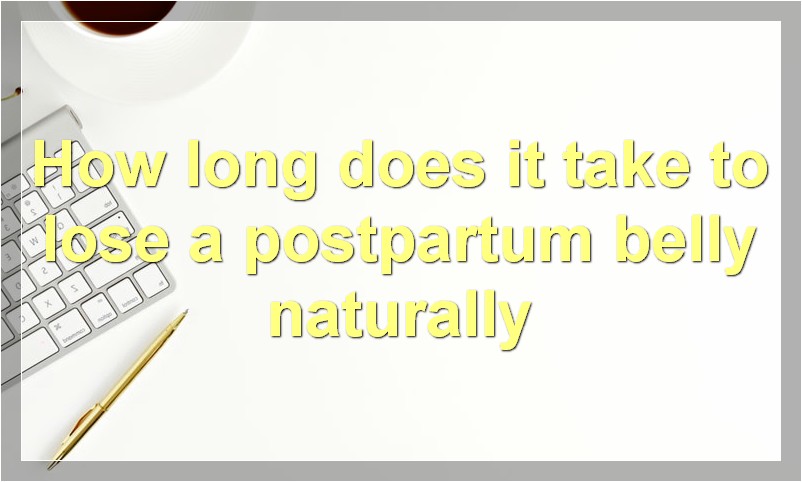C-section, or Cesarean section, is the delivery of a baby through a surgical incision in the mother’s abdomen. This type of delivery is typically reserved for when there are complications with the pregnancy that make a vaginal delivery too risky. C-sections are also sometimes scheduled in advance if the baby is very large or if the mother has a health condition that makes vaginal birth unsafe.
While a C-section is generally a safe and effective way to deliver a baby, there are some risks associated with the surgery. One of the most common concerns among women who have had a C-section is the development of a “hanging belly” or excess skin and fat around the midsection. This can occur when the skin and muscles around the incision are not able to snap back together after the surgery.
There are several things you can do to help get rid of a hanging belly after a C-section:
1) Get moving! Exercise will help to tone your abdominal muscles and improve circulation in the area, which can help to reduce excess skin and fat. Start slowly with some gentle exercises like walking or swimming and gradually increase the intensity as you feel comfortable.
2) Eat healthy! A balanced diet will help your body to heal after surgery and promote weight loss if you are carrying any extra pounds. Be sure to eat plenty of fruits, vegetables, lean proteins, and whole grains. Avoid processed foods, sugary drinks, and excessive amounts of salt.
3) Stay hydrated! Drinking plenty of water will help your skin to stay hydrated and elastic, which can prevent sagging skin. aim for 8 glasses per day.
4) Wear supportive clothing! Wearing a compression garment or girdle can help to hold everything in place while you heal. This can be especially helpful if you are breastfeeding as it will support your breasts and prevent them from sagging.
5) Try some topical treatments! There are several creams and lotions on the market that claim to tighten skin and reduce the appearance of cellulite. While there is no scientific evidence to support these claims, some women find them helpful. Ask your doctor before using any topical treatments on your incision site.
If you are concerned about the appearance of your stomach after a cesarean section, talk to your doctor about your options. They may recommend one or more of the above treatments or refer you to a plastic surgeon for further evaluation.
Why does the belly hang after a c-section?
The belly hangs after a c-section due to the incision made during the surgery. The incision is made through the abdominal muscles, which can cause the belly to protrude or “hang” after the surgery. This is usually temporary and will resolve itself over time.
How long does it take to lose a postpartum belly naturally?

Having a baby is an amazing experience that comes with lots of changes, both physically and emotionally. One of the biggest changes is to your body. It takes time for your body to recover from childbirth and get back to its pre-pregnancy state. For most women, it takes about six months to lose the pregnancy weight and get their bodies back to normal.
One of the common questions new moms ask is how long it will take to lose the postpartum belly. The answer depends on a few factors, including how much weight you gained during pregnancy, your starting weight, your diet, and your exercise routine.
If you are breastfeeding, you may also find that it takes longer to lose the pregnancy weight. This is because breastfeeding can help burn extra calories and promote weight loss.
Overall, it is important to be patient and give your body time to recover after having a baby. Losing weight too quickly can be unhealthy for both you and your baby. Try to focus on making healthy lifestyle choices and being active rather than worrying about how long it will take to lose the postpartum belly.
Which procedure is right for you?
There are many different procedures that can be used to improve your appearance. Some of the most popular procedures include:
– Botox injections
– Facelifts
– Rhinoplasty
– Breast implants
So, which procedure is right for you? It really depends on your individual goals and desires. If you want to achieve a more youthful appearance, then Botox or a facelift may be right for you. If you are unhappy with the size or shape of your nose, then rhinoplasty could be the answer. And if you want to enhance your breast size or shape, then breast implants may be the right choice.
Ultimately, the best way to decide which procedure is right for you is to consult with a board certified plastic surgeon. He or she will be able to evaluate your unique situation and help you make the best decision for your needs.
What are the risks of a c-section?
A c-section is a major surgery with all of the associated risks, including infection, hemorrhage, blood clots, and anesthesia complications. In addition, there is a risk of uterine rupture in future pregnancies and placental problems in subsequent pregnancies.
How can you prevent your stomach from hanging after a c-section?
After a c-section, your stomach may feel like it is hanging or sagging. This is because the muscles and tissue that support your stomach have been cut during the surgery. To prevent your stomach from hanging, you will need to:
1. Wear a supportive abdominal binder or girdle.
2. Avoid strenuous activity and heavy lifting for at least six weeks.
3. Sleep on your back with a pillow under your knees.
4. Eat a healthy diet and exercise regularly.
What are the benefits of a natural birth?

A natural birth is a childbirth process that does not involve any medical interventions, such as the use of drugs or surgery. It is also sometimes referred to as a “vaginal birth.”
There are many benefits of having a natural birth, for both mother and child. One of the most significant benefits is that it reduces the risk of complications. For example, the use of drugs during childbirth can increase the risk of respiratory problems for the baby.
Natural births also tend to be shorter than births that involve medical interventions. This is beneficial for both the mother and the baby, as it reduces the amount of time spent in labor and decreases the likelihood of complications.
Another benefit of natural childbirth is that it allows the mother to have an active role in the birthing process. This can help to increase bonding between mother and child, as well as provide a sense of empowerment for the mother.
Overall, natural childbirth is a safe and effective way to give birth, with many benefits for both mother and child.
How long does it take to recover from a natural birth?
The average length of time it takes to recover from a natural birth is six to eight weeks. However, every woman is different and some may experience a longer or shorter recovery period. Some women may also experience more discomfort and soreness than others.
What are the risks of a natural birth?
There are many risks associated with natural childbirth, including but not limited to:
1. Infection: One of the most common and serious complications associated with natural childbirth is infection. This can occur when the baby is born vaginally, exposing the mother to bacteria that can cause infection.
2. Bleeding: Another common complication of natural childbirth is excessive bleeding. This can happen when the placenta tears away from the uterine wall during delivery, or if the umbilical cord is cut too short.
3. Injury: Natural childbirth also carries a risk of injury to both the mother and baby. The most common injuries include lacerations (tears) to the vagina, perineum (the area between the vagina and anus), or anus.
4. Emotional Trauma: Natural childbirth can be an emotionally traumatic experience for both the mother and father. The stress of labor and delivery can lead to postpartum depression or other mental health issues.
What are the benefits of a c-section?
A c-section, or Cesarean section, is a surgical procedure used to deliver a baby through an incision in the mother’s abdomen and uterus. C-sections are generally performed when a vaginal delivery would be too risky for the mother or baby.
While c-sections are considered major surgery, they have become much safer in recent years. Thanks to advances in medical technology, the risks associated with c-sections are now lower than ever before.
There are several benefits of having a c-section, both for the mother and the child. For the mother, a c-section eliminates the risk of vaginal tearing and other complications that can occur during vaginal childbirth. It also allows the mother to avoid the pain of labor and delivery.
For the child, a c-section reduces the risk of birth injuries, such as those that can occur when the baby is pushed through the birth canal. Additionally, babies born via c-section are less likely to experience problems breathing at birth.
Overall, c-sections are safe and effective ways to deliver a baby. They offer many benefits for both the mother and child, and their risks are low. If you are pregnant and considering a c-section, talk to your doctor about whether it is the right choice for you.
How long does it take to recover from a c-section?
This is a difficult question to answer because it varies from person to person. A c-section is a major surgery, and like any surgery, it takes time to recover. The average person takes about six weeks to feel back to normal after a c-section. However, some people take longer, and some people never really feel the same again. C-sections are a serious surgery, and recovery can be a long and difficult process.




